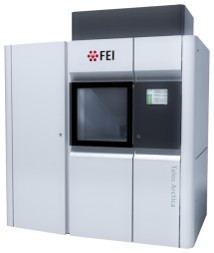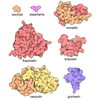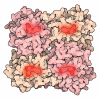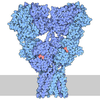[English] 日本語
 Yorodumi
Yorodumi- EMDB-64485: The VFT domains of human sweet taste receptor TAS1R2 and TAS1R3 i... -
+ Open data
Open data
- Basic information
Basic information
| Entry |  | |||||||||
|---|---|---|---|---|---|---|---|---|---|---|
| Title | The VFT domains of human sweet taste receptor TAS1R2 and TAS1R3 in the apo state | |||||||||
 Map data Map data | ||||||||||
 Sample Sample |
| |||||||||
 Keywords Keywords | GPCR / Taste / Tas1R2 / Tas1R3 / SIGNALING PROTEIN | |||||||||
| Function / homology |  Function and homology information Function and homology informationsweet taste receptor complex / detection of chemical stimulus involved in sensory perception of sweet taste / sweet taste receptor activity / taste receptor activity / sensory perception of umami taste / sensory perception of sweet taste / Class C/3 (Metabotropic glutamate/pheromone receptors) / positive regulation of cytokinesis / bioluminescence / G protein-coupled receptor activity ...sweet taste receptor complex / detection of chemical stimulus involved in sensory perception of sweet taste / sweet taste receptor activity / taste receptor activity / sensory perception of umami taste / sensory perception of sweet taste / Class C/3 (Metabotropic glutamate/pheromone receptors) / positive regulation of cytokinesis / bioluminescence / G protein-coupled receptor activity / Sensory perception of sweet, bitter, and umami (glutamate) taste / G alpha (i) signalling events / receptor complex / G protein-coupled receptor signaling pathway / Golgi apparatus / membrane / plasma membrane Similarity search - Function | |||||||||
| Biological species |  Homo sapiens (human) / Homo sapiens (human) /  Discosoma sp. (Sea anemone) (sea anemone) / Discosoma sp. (Sea anemone) (sea anemone) /  | |||||||||
| Method | single particle reconstruction / cryo EM / Resolution: 3.18 Å | |||||||||
 Authors Authors | Shi ZJ / Xu WX / Yue XL / Wu LJ / Hua T / Liu ZJ | |||||||||
| Funding support | 1 items
| |||||||||
 Citation Citation |  Journal: Nature / Year: 2025 Journal: Nature / Year: 2025Title: Structural and functional characterization of human sweet taste receptor. Authors: Zongjun Shi / Weixiu Xu / Lijie Wu / Xiaolei Yue / Shenhui Liu / Wei Ding / Jinyi Zhang / Bing Meng / Lianghao Zhao / Xiaoyan Liu / Junlin Liu / Zhi-Jie Liu / Tian Hua /  Abstract: Sweet taste perception influences dietary choices and metabolic health. The human sweet taste receptor, a class C G-protein-coupled receptor (GPCR) heterodimer composed of TAS1R2 and TAS1R3 (refs. ), ...Sweet taste perception influences dietary choices and metabolic health. The human sweet taste receptor, a class C G-protein-coupled receptor (GPCR) heterodimer composed of TAS1R2 and TAS1R3 (refs. ), senses a wide range of sweet compounds-including natural sugars, artificial sweeteners and sweet proteins-and affects metabolic regulation beyond taste. However, the lack of three-dimensional structures hinders our understanding of its precise working mechanism. Here we present cryo-electron microscopy structures of the full-length human sweet taste receptor in apo and sucralose-bound states. These structures reveal a distinct asymmetric heterodimer architecture, with sucralose binding exclusively to the Venus flytrap domain of TAS1R2. Combining mutagenesis and molecular dynamics simulations, this work delineates the sweetener-recognition modes in TAS1R2. Structural comparisons further uncover conformational changes upon ligand binding and a unique activation mechanism. These findings illuminate the signal transduction mechanisms of chemosensory receptors in the class C GPCR family and provide the molecular basis for the design of a new generation of sweeteners. | |||||||||
| History |
|
- Structure visualization
Structure visualization
| Supplemental images |
|---|
- Downloads & links
Downloads & links
-EMDB archive
| Map data |  emd_64485.map.gz emd_64485.map.gz | 108.4 MB |  EMDB map data format EMDB map data format | |
|---|---|---|---|---|
| Header (meta data) |  emd-64485-v30.xml emd-64485-v30.xml emd-64485.xml emd-64485.xml | 18.3 KB 18.3 KB | Display Display |  EMDB header EMDB header |
| FSC (resolution estimation) |  emd_64485_fsc.xml emd_64485_fsc.xml | 12.7 KB | Display |  FSC data file FSC data file |
| Images |  emd_64485.png emd_64485.png | 57 KB | ||
| Filedesc metadata |  emd-64485.cif.gz emd-64485.cif.gz | 7.1 KB | ||
| Others |  emd_64485_half_map_1.map.gz emd_64485_half_map_1.map.gz emd_64485_half_map_2.map.gz emd_64485_half_map_2.map.gz | 200.1 MB 200.1 MB | ||
| Archive directory |  http://ftp.pdbj.org/pub/emdb/structures/EMD-64485 http://ftp.pdbj.org/pub/emdb/structures/EMD-64485 ftp://ftp.pdbj.org/pub/emdb/structures/EMD-64485 ftp://ftp.pdbj.org/pub/emdb/structures/EMD-64485 | HTTPS FTP |
-Validation report
| Summary document |  emd_64485_validation.pdf.gz emd_64485_validation.pdf.gz | 1.1 MB | Display |  EMDB validaton report EMDB validaton report |
|---|---|---|---|---|
| Full document |  emd_64485_full_validation.pdf.gz emd_64485_full_validation.pdf.gz | 1.1 MB | Display | |
| Data in XML |  emd_64485_validation.xml.gz emd_64485_validation.xml.gz | 21.6 KB | Display | |
| Data in CIF |  emd_64485_validation.cif.gz emd_64485_validation.cif.gz | 28.1 KB | Display | |
| Arichive directory |  https://ftp.pdbj.org/pub/emdb/validation_reports/EMD-64485 https://ftp.pdbj.org/pub/emdb/validation_reports/EMD-64485 ftp://ftp.pdbj.org/pub/emdb/validation_reports/EMD-64485 ftp://ftp.pdbj.org/pub/emdb/validation_reports/EMD-64485 | HTTPS FTP |
-Related structure data
| Related structure data |  9ut9MC  9ut8C  9utaC  9utbC  9utcC M: atomic model generated by this map C: citing same article ( |
|---|---|
| Similar structure data | Similarity search - Function & homology  F&H Search F&H Search |
- Links
Links
| EMDB pages |  EMDB (EBI/PDBe) / EMDB (EBI/PDBe) /  EMDataResource EMDataResource |
|---|---|
| Related items in Molecule of the Month |
- Map
Map
| File |  Download / File: emd_64485.map.gz / Format: CCP4 / Size: 216 MB / Type: IMAGE STORED AS FLOATING POINT NUMBER (4 BYTES) Download / File: emd_64485.map.gz / Format: CCP4 / Size: 216 MB / Type: IMAGE STORED AS FLOATING POINT NUMBER (4 BYTES) | ||||||||||||||||||||||||||||||||||||
|---|---|---|---|---|---|---|---|---|---|---|---|---|---|---|---|---|---|---|---|---|---|---|---|---|---|---|---|---|---|---|---|---|---|---|---|---|---|
| Projections & slices | Image control
Images are generated by Spider. | ||||||||||||||||||||||||||||||||||||
| Voxel size | X=Y=Z: 0.96 Å | ||||||||||||||||||||||||||||||||||||
| Density |
| ||||||||||||||||||||||||||||||||||||
| Symmetry | Space group: 1 | ||||||||||||||||||||||||||||||||||||
| Details | EMDB XML:
|
-Supplemental data
-Half map: #1
| File | emd_64485_half_map_1.map | ||||||||||||
|---|---|---|---|---|---|---|---|---|---|---|---|---|---|
| Projections & Slices |
| ||||||||||||
| Density Histograms |
-Half map: #2
| File | emd_64485_half_map_2.map | ||||||||||||
|---|---|---|---|---|---|---|---|---|---|---|---|---|---|
| Projections & Slices |
| ||||||||||||
| Density Histograms |
- Sample components
Sample components
-Entire : heterodimer
| Entire | Name: heterodimer |
|---|---|
| Components |
|
-Supramolecule #1: heterodimer
| Supramolecule | Name: heterodimer / type: complex / ID: 1 / Parent: 0 / Macromolecule list: all |
|---|---|
| Source (natural) | Organism:  Homo sapiens (human) Homo sapiens (human) |
-Macromolecule #1: Taste receptor type 1 member 2,Engineered red fluorescent protein...
| Macromolecule | Name: Taste receptor type 1 member 2,Engineered red fluorescent protein mScarlet3 type: protein_or_peptide / ID: 1 Details: Engineered red fluorescent protein mScarlet3: PMID: 27869816 and PDB ID: 7ZCT Number of copies: 1 / Enantiomer: LEVO |
|---|---|
| Source (natural) | Organism:  Discosoma sp. (Sea anemone) (sea anemone) Discosoma sp. (Sea anemone) (sea anemone) |
| Molecular weight | Theoretical: 122.191227 KDa |
| Recombinant expression | Organism:  Homo sapiens (human) Homo sapiens (human) |
| Sequence | String: MKTIIALSYI FCLVFAGSDY KDDDDKGSAD FYLPGDYLLG GLFSLHANMK GIVHLNFLQV PMCKEYEVKV IGYNLMQAMR FAVEEINND SSLLPGVLLG YEIVDVCYIS NNVQPVLYFL AHEDNLLPIQ EDYSNYISRV VAVIGPDNSE SVMTVANFLS L FLLPQITY ...String: MKTIIALSYI FCLVFAGSDY KDDDDKGSAD FYLPGDYLLG GLFSLHANMK GIVHLNFLQV PMCKEYEVKV IGYNLMQAMR FAVEEINND SSLLPGVLLG YEIVDVCYIS NNVQPVLYFL AHEDNLLPIQ EDYSNYISRV VAVIGPDNSE SVMTVANFLS L FLLPQITY SAISDELRDK VRFPALLRTT PSADHHIEAM VQLMLHFRWN WIIVLVSSDT YGRDNGQLLG ERVARRDICI AF QETLPTL QPNQNMTSEE RQRLVTIVDK LQQSTARVVV VFSPDLTLYH FFNEVLRQNF TGAVWIASES WAIDPVLHNL TEL RHLGTF LGITIQSVPI PGFSEFREWG PQAGPPPLSR TSQSYTCNQE CDNCLNATLS FNTILRLSGE RVVYSVYSAV YAVA HALHS LLGCDKSTCT KRVVYPWQLL EEIWKVNFTL LDHQIFFDPQ GDVALHLEIV QWQWDRSQNP FQSVASYYPL QRQLK NIQD ISWHTINNTI PMSMCSKRCQ SGQKKKPVGI HVCCFECIDC LPGTFLNHTE DEYECQACPN NEWSYQSETS CFKRQL VFL EWHEAPTIAV ALLAALGFLS TLAILVIFWR HFQTPIVRSA GGPMCFLMLT LLLVAYMVVP VYVGPPKVST CLCRQAL FP LCFTICISCI AVRSFQIVCA FKMASRFPRA YSYWVRYQGP YVSMAFITVL KMVIVVIGML ATGLSPTTRT DPDDPKIT I VSCNPNYRNS LLFNTSLDLL LSVVGFSFAY MGKELPTNYN EAKFITLSMT FYFTSSVSLC TFMSAYSGVL VTIVDLLVT VLNLLAISLG YFGPKCYMIL FYPERNTPAY FNSMIQGYTM RRDGSSGLEV LFQGPSGGDS TEAVIKEFMR FKVHMEGSMN GHEFEIEGE GEGRPYEGTQ TAKLRVTKGG PLPFSWDILS PQFMYGSRAF TKHPADIPDY WKQSFPEGFK WERVMNFEDG G AVSVAQDT SLEDGTLIYK VKLRGTNFPP DGPVMQKKTM GWEASTERLY PEDVVLKGDI KMALRLKDGG RYLADFKTTY RA KKPVQMP GAFNIDRKLD ITSHNEDYTV VEQYERSVAR H UniProtKB: Taste receptor type 1 member 2 |
-Macromolecule #2: Taste receptor type 1 member 3,mNeonGreen
| Macromolecule | Name: Taste receptor type 1 member 3,mNeonGreen / type: protein_or_peptide / ID: 2 / Number of copies: 1 / Enantiomer: LEVO |
|---|---|
| Source (natural) | Organism:  |
| Molecular weight | Theoretical: 124.906602 KDa |
| Recombinant expression | Organism:  Homo sapiens (human) Homo sapiens (human) |
| Sequence | String: MKTIIALSYI FCLVFAGSDY KDDDDKGSAP LCLSQQLRMK GDYVLGGLFP LGEAEEAGLR SRTRPSSPVC TRFSSNGLLW ALAMKMAVE EINNKSDLLP GLRLGYDLFD TCSEPVVAMK PSLMFLAKAG SRDIAAYCNY TQYQPRVLAV IGPHSSELAM V TGKFFSFF ...String: MKTIIALSYI FCLVFAGSDY KDDDDKGSAP LCLSQQLRMK GDYVLGGLFP LGEAEEAGLR SRTRPSSPVC TRFSSNGLLW ALAMKMAVE EINNKSDLLP GLRLGYDLFD TCSEPVVAMK PSLMFLAKAG SRDIAAYCNY TQYQPRVLAV IGPHSSELAM V TGKFFSFF LMPQVSYGAS MELLSARETF PSFFRTVPSD RVQLTAAAEL LQEFGWNWVA ALGSDDEYGR QGLSIFSALA AA RGICIAH EGLVPLPRAD DSRLGKVQDV LHQVNQSSVQ VVLLFASVHA AHALFNYSIS SRLSPKVWVA SEAWLTSDLV MGL PGMAQM GTVLGFLQRG AQLHEFPQYV KTHLALATDP AFCSALGERE QGLEEDVVGQ RCPQCDCITL QNVSAGLNHH QTFS VYAAV YSVAQALHNT LQCNASGCPA QDPVKPWQLL ENMYNLTFHV GGLPLRFDSS GNVDMEYDLK LWVWQGSVPR LHDVG RFNG SLRTERLKIR WHTSDNQKPV SRCSRQCQEG QVRRVKGFHS CCYDCVDCEA GSYRQNPDDI ACTFCGQDEW SPERST RCF RRRSRFLAWG EPAVLLLLLL LSLALGLVLA ALGLFVHHRD SPLVQASGGP LACFGLVCLG LVCLSVLLFP GQPSPAR CL AQQPLSHLPL TGCLSTLFLQ AAEIFVESEL PLSWADRLSG CLRGPWAWLV VLLAMLVEVA LCTWYLVAFP PEVVTDWH M LPTEALVHCR TRSWVSFGLA HATNATLAFL CFLGTFLVRS QPGCYNRARG LTFAMLAYFI TWVSFVPLLA NVQVVLRPA VQMGALLLCV LGILAAFHLP RCYLLMRQPG LNTPEFFLGG GPGDAQGQND GNTGNQGKHE GSSGLEVLFQ GPSGGVSKGE EDNMASLPA THELHIFGSI NGVDFDMVGQ GTGNPNDGYE ELNLKSTKGD LQFSPWILVP HIGYGFHQYL PYPDGMSPFQ A AMVDGSGY QVHRTMQFED GASLTVNYRY TYEGSHIKGE AQVKGTGFPA DGPVMTNSLT AADWCRSKKT YPNDKTIIST FK WSYTTGN GKRYRSTART TYTFAKPMAA NYLKNQPMYV FRKTELKHSK TELNFKEWQK AFTDVMGMDE LYKGSENLYF QSS GHHHHH HHHH UniProtKB: Taste receptor type 1 member 3, mNeonGreen |
-Experimental details
-Structure determination
| Method | cryo EM |
|---|---|
 Processing Processing | single particle reconstruction |
| Aggregation state | particle |
- Sample preparation
Sample preparation
| Buffer | pH: 7.4 |
|---|---|
| Vitrification | Cryogen name: ETHANE |
- Electron microscopy
Electron microscopy
| Microscope | FEI TALOS ARCTICA |
|---|---|
| Image recording | Film or detector model: FEI FALCON IV (4k x 4k) / Average electron dose: 60.0 e/Å2 |
| Electron beam | Acceleration voltage: 300 kV / Electron source:  FIELD EMISSION GUN FIELD EMISSION GUN |
| Electron optics | Illumination mode: FLOOD BEAM / Imaging mode: BRIGHT FIELD / Nominal defocus max: 2.2 µm / Nominal defocus min: 1.2 µm |
| Experimental equipment |  Model: Talos Arctica / Image courtesy: FEI Company |
 Movie
Movie Controller
Controller











 Z (Sec.)
Z (Sec.) Y (Row.)
Y (Row.) X (Col.)
X (Col.)





































